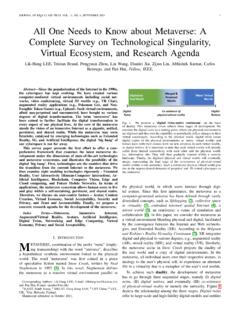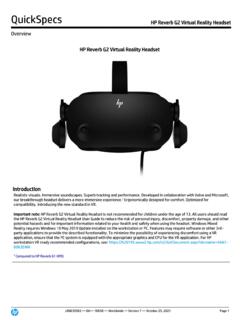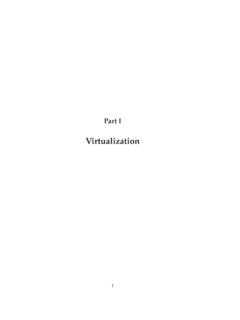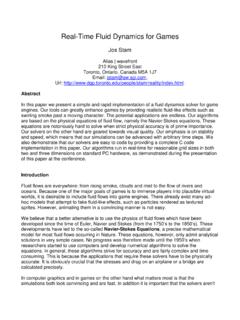Transcription of Reasons to Use Virtual Reality in Education and Training ...
1 THEMES IN SCIENCE AND TECHNOLOGY Education Special Issue, Pages 59-70 Klidarithmos Computer Books 59 Reasons to Use Virtual Reality in Education and Training Courses and a Model to Determine When to Use Virtual Reality Veronica S. Pantelidis Department of Library Science, College of Education , East Carolina University, Greenville, North Carolina, USA Abstract Many studies have been conducted on the use of Virtual Reality in Education and Training . This article lists examples of such research. Reasons to use Virtual Reality are discussed. Advantages and disadvantages of using Virtual Reality are presented, as well as suggestions on when to use and when not to use Virtual Reality . A model that can be used to determine when to use Virtual Reality in an Education or Training course is presented.
2 Use of Virtual Reality in Education The use of Virtual Reality (VR) in Education can be considered as one of the natural evolutions of computer-assisted instruction (CAI) or computer-based Training (CBT). Use of computers as instructional aids has a long history going back to the early 1950s. Serious studies began in the early 1960s. Since the advent of the microcom-puter in 1977, computers, particularly microcomputers or personal computers (PCs), have become a growing and recognized delivery system for many forms of Education . Virtual Reality , which can be used on all types of computers, has followed that trend. In her extensive bibliography on Virtual Reality in Education and Training , Pantelidis (1991-2009) lists over 800 printed resources, such as articles and reports, on this application of Virtual Reality , going back to 1989.
3 The list is by no means complete and comprehensive. Research on the use of Virtual Reality in Education Many studies have been conducted on the applications and effectiveness of Virtual Reality in Education and Training since the 1980s. McLellan (1996, 2003) provides V. S. Pantelidis 60 comprehensive and in-depth reviews of the literature related to the research and use of Virtual Reality for Education and Training in editions of The Handbook of Research for Educational Communications and Technology. McLellan traces early use of Virtual Reality in Training to flight simulators with head-mounted displays developed at Wright-Patterson Air Force Base in Ohio in the 1960s and 1970s (1996, p. 458.). Youngblut (1998) conducted an extensive survey of research and educational uses of Virtual Reality during the 1990 s.
4 The survey attempted to answer questions about the use and effectiveness of Virtual Reality in kindergarten through grade 12 educa-tion. Youngblut found that there are unique capabilities of Virtual Reality , and the ma-jority of uses included aspects of constructivist learning (1998, p. 93). Studies showed potential educational effectiveness for special needs students (1998, p. 98). The role of the teacher changed to facilitator (1998, p. 100). Students enjoy using pre-developed applications and developing their own Virtual worlds (1998, p. 100). The majority of the teachers in the studies reviewed said they would use Virtual Reality technology if it were affordable, available, and easy to use for students and teachers (1998, p. 101). Chen (2006) asserts that although VR is recognized as an impressive learning tool, there are still many issues that need further investigation including, identifying the appropriate theories and/or models to guide its design and development, investigat-ing how its attributes are able to support learning, finding out whether its use can improve the intended performance and understanding, and investigating ways to reach more effective learning when using this technology, and investigating its im-pact on learners with different aptitudes.
5 Her research resulted in insights to a fea-sible instructional design theoretical framework, as well as an instructional devel-opment framework for VR-based learning environments (2006, p. 39). A model developed by Salzman, Dede, Loftin, and Chen (1999) describes how Virtual Reality aids complex conceptual learning, and how Virtual Reality s features and other factors shape the learning process and learning outcomes. The model resulted from a study to identify, use, and evaluate immersive Virtual Reality 's affordances as a means to facilitate the mastery of complex, abstract concepts. Studies show that a Virtual environment can stimulate learning and comprehension, because it provides a tight coupling between symbolic and experiential information (Bowman, Hodges, Allison, & Wineman, 1998).
6 Numerous studies have focused on how children and young learners interact and learn in a 3D environment. Children and young learners have been studied in high-end projection environments, such as a CAVE (Roussos, Johnson, Moher, Leigh, Vasilakis, & Barnes, 1999). Their activity within interactive Virtual environments has been examined to learn how interaction and conceptual learning are related in the context of a Virtual environment, the Vir-tual Playground (Roussou, 2004a; Roussou, 2004b; Roussou, Oliver, & Slater, 2006). Reasons to Use VR in Education and Training 61 Chee (2001) argues for the need to root learning in experience, using physics as an example. He states that physics students have little feel and understanding of the qualitative dimensions of the phenomena they study . Chee believes that Virtual real-ity can be used to achieve this goal, providing a foundation for students' conceptual and higher-order learning.
7 Dalgarno, Hedberg, and Harper (2002) believe that the most important potential con-tribution of 3D learning environments (3 DLEs) to conceptual understanding is through facilitation of spatial knowledge development. They have identified aspects of a research agenda to test this, including exploration of the characteristics of 3 DLEs that are most important for spatial learning along with issues in designing ap-propriate learning tasks . Selvarian (2004) researched the potential of spatial and social technologies in a vir-tual learning environment (VLE) through presence. She proposed a VLE model and hypotheses that correlated the spatial and social technologies with spatial and social presence, respectively, and with low- and high-level learning, respectively. Findings from her research offer educators a valuable guide for the design of VLEs that en-hance low- and high-level learning through spatial and social presence.
8 Reasons to use Virtual Reality in Education and Training Reasons to use Virtual Reality can parallel all the Reasons one would use a two-dimensional, computer-assisted instruction simulation (Pantelidis, 1993). At every level of Education , Virtual Reality has the potential to make a difference, to lead learn-ers to new discoveries, to motivate and encourage and excite. The learner can par-ticipate in the learning environment with a sense of presence, of being part of the en-vironment. The Reasons to use Virtual Reality in Education and Training relate particularly to its capabilities. Winn (1993), in A conceptual basis for educational applications of Virtual Reality , states that 1) Immersive VR furnishes first-person non-symbolic experiences that are specifi-cally designed to help students learn material.
9 2) These experiences cannot be obtained in any other way in formal Education . 3) This kind of experience makes up the bulk of our daily interaction with the world, though schools tend to promote third-person symbolic experiences. 4) Constructivism provides the best theory on which to develop educational appli-cations of VR. 5) The convergence of theories of knowledge construction with VR technology permits learning to be boosted by the manipulation of the relative size of objects in Virtual worlds, by the transduction of otherwise imperceptible sources of in-V. S. Pantelidis 62 formation, and by the reification of abstract ideas that have so far defied repre-sentation . Winn concludes that VR promotes the best and probably only strategy that allows students to learn from non-symbolic first-person experience.
10 Since a great many stu-dents fail in school because they do not master the symbol systems of the disciplines they study, although they are perfectly capable of mastering the concepts that lie at the heart of the disciplines, it can be concluded that VR provides a route to success for children who might otherwise fail in our Education system as it is currently con-strued . Pantelidis (1995) gives the following Reasons to use Virtual Reality in Education : Virtual Reality provides new forms and methods of visualization, drawing on the strengths of visual representations. It provides an alternate method for presen-tation of material. In some instances, VR can more accurately illustrate some fea-tures, processes, and so forth than by other means, allowing extreme close-up examination of an object, observation from a great distance, and observation and examination of areas and events unavailable by other means.
















